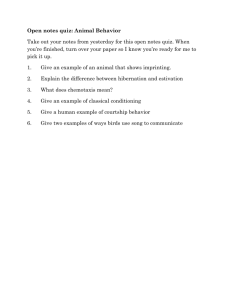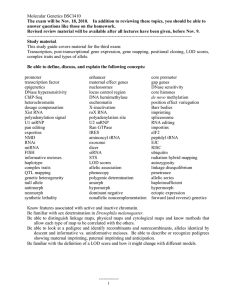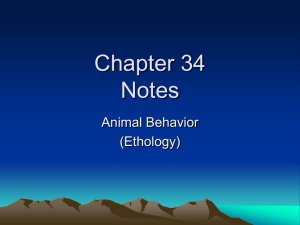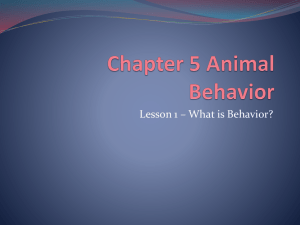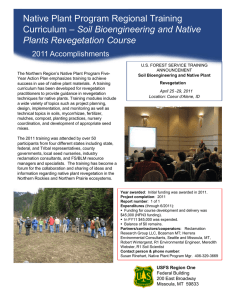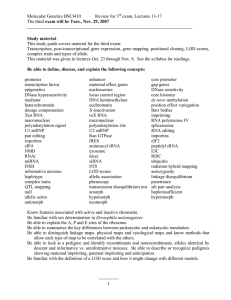Document 11871754
advertisement
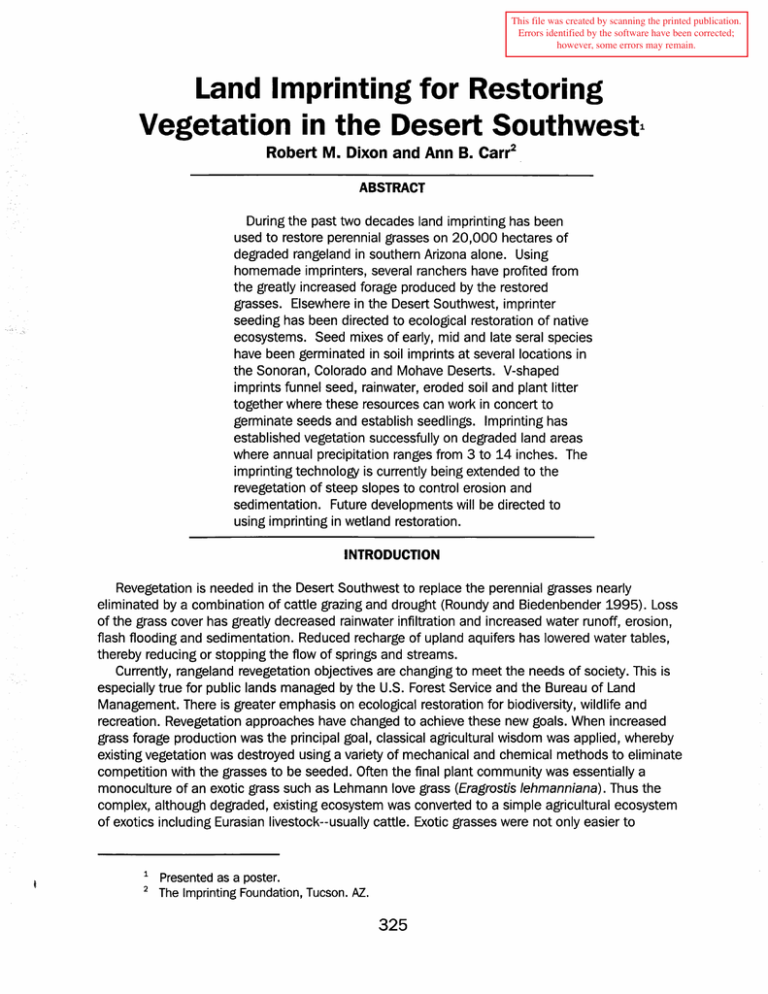
This file was created by scanning the printed publication. Errors identified by the software have been corrected; however, some errors may remain. Land Imprinting for Restoring Vegetation in the Desert Southwestl Robert M. Dixon and Ann B. Carr2 ABSTRACT During the past two decades land imprinting has been used to restore perennial grasses on 20,000 hectares of degraded rangeland in southern Arizona alone. Using homemade imprinters, several ranchers have profited from the greatly increased forage produced by the restored grasses. Elsewhere in the Desert Southwest, imprinter seeding has been directed to ecological restoration of native ecosystems. Seed mixes of early, mid and late seral species have been germinated in soil imprints at several locations in the Sonoran, Colorado and Mohave Deserts. V-shaped imprints funnel seed, rainwater, eroded soil and plant litter together where these resources can work in concert to germinate seeds and establish seedlings. Imprinting has established vegetation successfully on degraded land areas where annual precipitation ranges from 3 to 14 inches. The imprinting technology is currently being extended to the revegetation of steep slopes to control erosion and sedimentation. Future developments will be directed to using imprinting in wetland restoration. INTRODUCTION Revegetation is needed in the Desert Southwest to replace the perennial grasses nearly eliminated by a combination of cattle grazing and drought (Roundy and Biedenbender 1995). Loss of the grass cover has greatly decreased rainwater infiltration and increased water runoff, erosion, flash flooding and sedimentation. Reduced recharge of upland aquifers has lowered water tables, thereby reducing or stopping the flow of springs and streams. Currently, rangeland revegetation objectives are changing to meet the needs of society. This is especially true for public lands managed by the U.S. Forest Service and the Bureau of Land Management. There is greater emphasis on ecological restoration for biodiversity, wildlife and recreation. Revegetation approaches have changed to achieve these new goals. When increased grass forage production was the principal goal, classical agricultural wisdom was applied, whereby existing vegetation was destroyed using a variety of mechanical and chemical methods to eliminate competition with the grasses to be seeded. Often the final plant community was essentially a monoculture of an exotic grass such as Lehmann love grass (Eragrostis lehmanniana). Thus the complex, although degraded, existing ecosystem was converted to a simple agricultural ecosystem of exotics including Eurasian livestock--usually cattle. Exotic grasses were not only easier to 1 2 Presented as a poster. The Imprinting Foundation, Tucson. AZ. 325 establish in the degraded rangeland, but also could cope better with the intense grazing of large exotic ungulates, having co-evolved with them in Africa and elsewhere. RESULTS AND DISCUSSION The new land treatment process, land imprinting, has been under development since 1976 when the first imprinter was fabricated in the machine shop at the USDA's Walnut Gulch Experimental Watershed which surrounds Tombstone, Arizona (Dixon and Simanton 1977) Development of this new method has been driven by two needs. First was the fact that the rangeland drill, often considered the best conventional method, was only marginally successful about one time out of ten. And next was the growing need for a method that would restore perennial grasses without destroying the existing vegetation; i.e., an effective method for inter seeding the missing ecosystem component. Imprinter seeding, when done properly, has been successful about nine times out of ten both for increasing forage production and ecological restoration. The greater success of imprinting relative to drilling was attributed to greatly improved control of rainwater at the soil surface (Dixon 1990). Ranchers, using homemade imprinters, have inter seeded perennial grasses on some 20,000 hectares of degraded rangeland in southern Arizona, alone. Failure of imprinter seeding has almost always been directly attributable to either poor imprints or poor seed or both. Poor imprints result from the use of substandard equipment and/or operating procedures. Poor imprints are those which are relatively shallow and/or unstable. Poor seed can have a number of causes, but perhaps the most common one is insufficient pioneer species in the seed mix to improve the microenvironment enough to help in the establishment of later seral species. These pioneer species serve as cover, nurse, mulch and green manure plants. They are especially needed where the land has been severely disturbed and the revegetation objective is ecological restoration. Shallow or partial imprints result from a poorly designed imprinting roller, insufficient imprinter ballast or extremely hard soils. Ripping to soften extremely hard rangeland soils should not be done as an alternative to adding more imprinter ballast unless the imprinting pressure required for an adequate imprint exceeds 345kPa (50 psi.). Another alternative is to wait until a rain has softened the soil an approach especially appropriate for fall seeding of rocky rangeland soils. Imprint instability may be caused by initial till age, lack of surface cover such as plant litter or gravel and coarse (sandy) soil texture. Time of imprinting also affects imprint stability. Fall imprinting is recommended because of the prevalence of gentle rains which settle and stabilize the imprint geometry. A rapid-growing cover crop of cool season annual grasses will further stabilize imprints before they are exposed subsequently to the highly erosive summer monsoonal rainfall. Special care should be taken to stabilize imprints in sandy soil which tends to be inherently unstable. Till age prior to imprinting should be avoided as it regresses the secondary succession back to the starting point or to a thick stand of severely competitive pioneer plants. Such till age, not only kills desirable plants, but also severely disrupts the soil ecosystem which otherwise would facilitate the establishment of perennial grasses and ecosystem restoration. Disruption of cryptogamic crusts, mycorrhizal fungi and invertebrate communities is especially harmful to the natural functioning of soil ecosystems. Till age also accelerates oxidation of organic matter and the breakdown of soil structure. Increasingly, imprinter seeding is being directed to ecological restoration of desert savannas instead of grass forage production. Good seed mixes are fundamental to the success of such projects. Failure or limited success is often the result of not using enough early sera I species. They stabilize and improve the soil for later seral species. Two large scale projects in the Sonoran desert near Tucson, Arizona will serve to exemplify the general approach to ecological restoration of 326 severely degraded land through imprinter seeding (Dixon and Carr 1993). In the first project, an 8-km stretch (240 ha) of severely disturbed floodplain along the Santa Cruz River was imprinter seeded during November 1987. The disturbed floodplain had been leveled, straightened, and walled to allow housing development within most of the outlying historic floodplain. Revegetation was required to mitigate the hydrologic effects of reshaping the floodplain including accelerated flow of floodwater, floodplain erosion, and downstream sedimentation. In the second project, a strip of severely disturbed land in the foothills of the Tucson mountains was seeded during November 1991. The 80-ha strip, 11 km in length, was disturbed during the installation of a large underground aqueduct by the Central Arizona Project to supply irrigation water to the San Xavier Indian Reservation. Complex native seed mixes, which were used at both project locations, included early, mid and late successional species to help accelerate the secondary succession toward a stable plant community with biodiversity equal to or greater than relatively undisturbed nearby areas. Thick stands of exotic weeds, present at the time of imprinting at both locations, served well in the roles of cover, nurse, mulch and green manure. Imprinting converted these weeds into a water saving, soil enriching mulch partially imbedded in the faces of the imprint. Many species within the seed mix responded rapidly to the imprinted seedbeds and seedling cradles. Consequently, plant communities at both locations are progressing rapidly toward the biodiversity goal. The V-shaped imprints funnel resources together at the imprint bottom where they can work in concert to germinate seeds and establish seedlings. The imprints also protect small seedlings against the desiccating effects of strong winds and hot sunlight to help them get their roots down before they have to face the severe macro climate above. The relatively long life of imprints and natural seed dormancy greatly increase the chances for imprinting success relative to conventional drilling of seed. Thus, imprints and seeds can last through several years of drought and still function to germinate seeds and establish seedlings when the rains finally come. Land imprinting arose from extensive infiltration studies which found that degraded/desertified land surfaces become smooth and sealed and as a consequence shed most of the rainwater instead of infiltrating it (Dixon, 1995). Imprinting was conceived as the most benign method possible for restoring the surface micro roughness and macro porosity to, in turn, accelerate infiltration and revegetation processes (Dixon and Simanton 1977). Imprints are formed by downward acting forces (much like foot and hoof prints) without soil surface inversion, uprooting of plants, covering of plant materials, and destruction of cryptogamic crusts, mycorrhizae and soil invertebrates. Imprints are well-firmed and well-formed V-shaped pockets which funnel rainwater, plant litter, splash eroded soil and seeds together where these resources can work in concert to germinate seeds and establish seedlings (Dixon and Carr 1994). Since the imprints are small closed micro watersheds (usually about 30-cm square) they do not bleed resources downslope as do the furrows of conventional methods such as drill seeding. Thus, imprinting goes a long way toward achieving the long held conservation goal of holding soil and water resources in place to maximize biomass production while maintaining and building topsoil for sustainable productivity indefinitely into the future. SUMMARY AND CONCLUSIONS Imprinter seeding is highly successful in the Desert Southwest for increasing grass forage production for livestock and for restoring ecosystems for biodiversity, wildlife and recreation. However, these goals are often somewhat incompatible and thus cannot be achieved to the maximum degree on the same land area at the same time. Correct use of the new imprinting technology requires a marked departure from conventional agricultural wisdom for growing annual crops and the application of ecological principles for accelerating secondary succession of plant communities following land disturbances. 327 Common problems and mistakes which limit the success of imprinter seeding include: 1. Poorly designed imprinting roller. 2. Prior till age for weed and brush control. 3. Inadequate ballast for a full-tooth imprint. 4. Operating imprinter in wet soil that sticks to the imprinting teeth. 5. Failure to rip soil that has been deeply compacted by heavy equipment. 6. Seed mix with insufficient early sera I species present to accelerate the secondary succession Rnally success in imprinter seeding as in most no-till methods requires perseverance and the belief that it will work if done properly (Orchard 1996). It's not so much a question of whether imprinter seeding will work, but rather how can it be made to work? Making imprinting work in a variety of new situations may require minor modifications in the standard equipment and operating procedures. Imprinting equipment is currently being adapted for use on steep slopes (Dixon and Carr, In Press). This entails the development of an imprinting tooth with a curvilinear triangular cross section to increase water and seed storage space on steep slopes. Additionally, crawler tractors with self-cleaning triangular track pads can be readily adapted to imprinting steep slopes. An imprinting roller clamped to the dozer blade will imprint the space between the tracks. This same arrangement can be easily adapted to wetland restoration. REFERENCES Dixon, R.M. 1990. Land imprinting for dry land revegetation and restoration. In: Environmental Restoration: Sciences and Strategies for Restoring the Earth. Edited, John J. Berger. Island Press, Washington, D.C. p. 14-22. Dixon, R.M. 1995. Water Infiltration control at the soil surface: Theory and practice. Journal of Soil and Water Conservation 50 (5): 450-453. Dixon, R.M. and A.B. Carr. 1993. Recent revegetation projects in southern Arizona using land imprinting. Abstracts Eighth Wildland Shrub Symposium Shrub Research Consortium, University of Nevada, Las Vegas. Oct. 19-21. p.30-31. Dixon, R.M. and A.B. Carr. 1994.Land imprinting for low-cost revegetation. Erosion Control! (3): 38-43. Dixon, R.M. and A.B. Carr. In Press. Infiltration regulation for erosion control: Principles and practices. Proceedings International Erosion Control Association, 281h Conference. Nashville, Tennessee, 25-28 Feb, 1997. Dixon, R.M. and J.R. Simanton. 1977. A land imprinter for revegetation of barren land areas through infiltration control. Arizona-Nevada Acad. Sci. and Anl Water Resources Assoc. 7: 79-88. Orchard, Julie. 1996. No-till takes perseverance. No-Till Farmer, Lessiter Publications, Oct.. p. 8. Roundy, B.A. and S.H. Biedenbender.1995.Revegetation in desert grassland. In: Desert Grasslands. Edited, Mitchell P. McClaran and Thomas R. VanDevender. University of Arizona Press, Tucson, Arizona. p.265-303. 328

